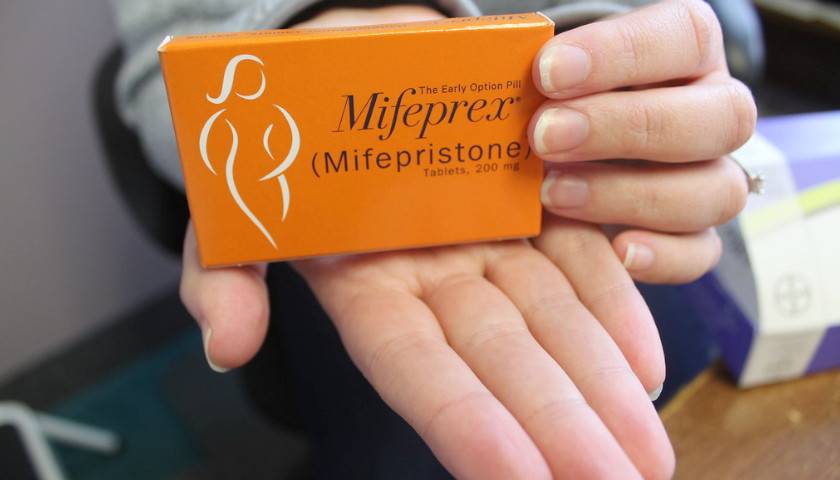by Greg Piper
Federal public health officials created strange bedfellows among animal-welfare advocates, scientists and vaccine skeptics for allegedly cutting corners in viral and COVID-19 vaccine research and oversight, possibly engineering a pathogen, then a cure that’s worse for some.
The Food and Drug Administration may be creating another odd couple in a case at the Supreme Court: environmental and pro-life activists.
The agency flouted the Endangered Species Act to approve the chemical abortion drug mifepristone, used in conjunction with misoprostol, and progressively make it more widely available over several years, Students for Life of America argued in a friend-of-the-court brief Tuesday.
The FDA neglected a required interagency “consultation” with the U.S. Fish and Wildlife Service and National Marine Fisheries Service starting with approval in 2000 and four alterations of the “risk evaluation and mitigation strategies” for mifepristone going back to 2016, the brief says.
It’s coauthored by longtime U.S. Anti-Doping Agency General Counsel William Bock, who left the agency in 2020. He was the lead attorney for USADA’s investigation of Lance Armstrong’s U.S. Postal Service Cycling Team and its use of performance-enhancing drugs.
Abortion is the #1 killer of Black Americans. pic.twitter.com/q3GVTgXO0a
— Students for Life of America | Pro-Life Gen (@StudentsforLife) February 26, 2024
Pro-life medical groups including the Alliance for Hippocratic Medicine and American Association of Pro-Life Obstetricians & Gynecologists sued the agency for allegedly violating the Administrative Procedure Act by removing most of the safety standards for mifepristone in 2016 and the in-person visit requirement in 2021 without reliable or any safety evidence.
The 5th U.S. Circuit Court of Appeals ruled last summer the FDA violated the act and the medical groups had legal standing because their members treated women who suffered adverse events from the drug, but SCOTUS blocked it pending review.
Former GOP presidential candidate Vivek Ramaswamy has said the case is not about abortion but administrative law, arguing the FDA never had congressional authority to approve mifepristone in the first place.
SFLA told Just the News it’s not aware of any other party or filer in the docket invoking environmental law to challenge the FDA’s actions, but it’s following in the footsteps of 5th Circuit Judge James Ho’s concurrence in the mifepristone ruling.
While he agreed with the rest of the three-judge panel on standing and APA violations, Ho said the groups also suffered “aesthetic injury,” a concept taken from environmental rulings.
Just as federal courts have ruled that people with “concrete plans” to visit animal habitats threatened by federal decisions have standing to challenge those projects – SCOTUS said “the very subject of [their] interest will no longer exist” – so do “[d]octors delight in working with their unborn patients – and experience an aesthetic injury when they are aborted,” Ho wrote.
The concurrence drew criticism from some law scholars who claimed it dehumanized women, Bloomberg reported at the time, though Ho cited “[e]xpectant parents” first in his list of those who experience “profound joy” from viewing “[u]nborn babies.”
🚨🎉New from @ColumbiaLaw's Science, Health & Information Clinic🚨🎉
Amicus brief on behalf of @drsforamerica & The Reproductive Health Coalition, submitted to the US Supreme Court at the merits stage of Alliance for Hippocratic Medicine v. FDA
Our biggest and best brief yet!
1/ pic.twitter.com/TQHu51hT8H— Chris Morten (@cmorten2) February 1, 2024
SFLA’s brief says its members, most of whom are women and many of those “working mothers,” comprise “the generation most targeted for abortion.” It fights “misogynist presuppositions – including statements in court findings – that abortion contributes to women’s prosperity.”
But the group quickly pivoted to its “desire to protect the environment from Mifepristone and its active metabolites … for future generations to see and experience,” citing certain pollution of federal waterways, destruction of habitats and further pressure on the most vulnerable species without a full environmental review.
The FDA’s aloof attitude toward its ESA obligations started in 2000, when it breezily claimed mifepristone’s approval was “not anticipated” to harm threatened or endangered species, SFLA said.
It didn’t review how the “excretion” of the drug itself would affect the environment, just the “packaging, production waste, and pharmaceutical waste,” and underestimated how many women would use the drug, now “the most popular form of abortion” in America.
The agency did the same in 2016, 2019, 2021 and 2023, the third of which was particularly dangerous because it “opened the floodgates to do-it-yourself home abortions, leading to a massive increase in the disposal of Mifepristone into our nation’s waterways,” the brief says.
It names and depicts several of the most allegedly vulnerable species to mifepristone among nearly 1,500 in the feds’ threatened and endangered list.
With fewer than 50 in the wild, “[t]he red wolf is at one of the more sensitive stages of reintroduction” into its traditional “wetlands, forest, and some agricultural lands,” the brief says. The freshwater leopard darter’s habitat “is often connected to outflows from sewage processing plants and other human elements that can cause disruption.”
More than $35 million has been spent to save the California condor, and with fewer than 600 in the wild and captivity, they face particular risk because they will “consume nearly any non-bird carcass they come across, including aquatic creatures” in mifepristone-tainted waterways.
Sockeye salmon populations in the Pacific Northwest “are not experiencing a resurgence in population” like their soho and Chinook cousins and are “heavily impacted by human activity in those waters,” according to the brief. It says their populations in Oregon and Idaho went “completely extinct” and others across North America reached “50-year lows.”
The Alliance Defending Freedom filed the opening brief on behalf of the pro-life medical groups last week.
Join @aaplog Pro-Life Supreme Court rally: Alliance for Hippocratic Medicine v. FDA on March 26, 2024. Learn more and RSVP: https://t.co/hWoy7pZA9t pic.twitter.com/HPULlJwUlz
— Massachusetts Citizens for Life (@MassProLife) February 21, 2024
The FDA “expressly counted on OB/GYN hospitalists and emergency-room doctors” to manage mifepristone complications when yanking its safety standards, and they “have no choice but to provide immediate treatment” despite harming their consciences by participating in abortion, it says. “This is no ordinary agency action.”
The agency admitted relying on “insufficient” data and studies to remove the in-person visit, used to “screen for ectopic pregnancies and other dangerous conditions,” and refused to conduct “studies examining the changes as a whole” or explain “why cumulative studies were unnecessary” for the 2016 changes, the groups say.
The high court recently rejected motions by the American Bar Association to file a brief in support of the feds and mifepristone’s brand and generic drug makers, and Minnesota lawyer Greg Roden to represent the “real parties in interest” – unborn human beings.
SCOTUS also denied a motion to intervene by Missouri, Kansas and Idaho attorneys general, which argued they can uniquely assert monetary harm to state-run insurance programs from mifepristone-injured women returning to their states from others where they received the drug.
– – –
Greg Piper has covered law and policy for nearly two decades, with a focus on tech companies, civil liberties and higher education.
Photo “Mifepristone” by Robin Marty. CC BY 2.0.






